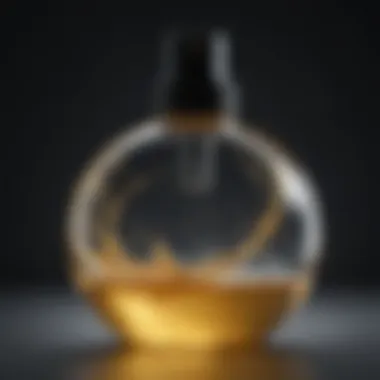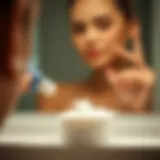Neutralizing Yellow Tones: The Power of Effective Toners


Intro
The pursuit of achieving flawless hair color often leads to challenges, particularly when it comes to unwanted yellow tones. These yellow or brassy hues can emerge from various factors, including environmental influences, natural hair pigments, and the chemical processes involved in dyeing. Understanding how to tackle this issue is essential for anyone who desires a harmonious and vibrant hair color. Effective toners present a solution that allows individuals to neutralize these unwanted yellow tones, restoring balance and enhancing their overall appearance.
This article will delve into the effectiveness of toners. It will highlight the underlying causes that contribute to yellowing, explore the chemistry behind toners, and discuss various application methods. Moreover, practical tips will be provided to help readers select the ideal toner for their unique hair types. With this comprehensive guide, readers will be equipped to make informed choices in their hair care routine, culminating in beautiful and well-maintained hair.
Tips and How-Tos
Selecting the Right Toner
Choosing an appropriate toner can greatly impact the end result. To identify the best toner for your hair, consider the following:
- Assess Your Hair Type: Understanding whether your hair is fine, medium, or coarse can influence how a toner works. Fine hair may require a lighter application, while coarse hair can benefit from a stronger formulation.
- Determine Your Desired Result: Are you aiming for a cool, ashy blonde? Or perhaps a subtle enhancement of your existing color? Knowing your goal helps in selecting the correct shade.
- Read Product Ingredients: Ingredients like purple pigments are common in toners for canceling out yellow tones. Look for formulations that specifically address yellowing, such as Schwarzkopf BlondMe Tone Enhancing* or Wella Color Charm T18.
Application Techniques
Applying toner correctly is crucial for optimal results. Here are steps that can guide you:
- Start with Clean Hair: Wash your hair to remove product buildup for more efficient toner absorption.
- Section Your Hair: Divide your hair into manageable sections to ensure even application across all strands.
- Use a Brush for Precision: Apply toner with a color brush for accuracy, focusing on areas that require the most attention.
- Follow Timing Instructions: Adhere strictly to the time recommended on the product label to avoid over-toning, which can lead to an unintended color shift.
Always perform a strand test before applying toner to your entire head. This can help gauge the expected results and avoid disappointment.
Sustainable Practices
As the beauty industry shifts towards sustainable practices, it is essential to consider eco-friendly options when selecting hair care products. Many brands now offer sustainable toners that utilize natural ingredients and environmentally responsible packaging. When choosing products, look for:
- Brands that prioritize recyclable or biodegradable packaging.
- Formulations that are free from harmful chemicals, ensuring a lower environmental impact.
Celebrating Diversity in Beauty
Beauty standards are not monolithic, and the quest for achieving the perfect hair color can differ greatly across cultures. Diverse beauty brands have emerged to cater to a wide range of hair types and preferences. This inclusivity is essential, as it acknowledges the unique challenges faced by various hair textures and colors. Embracing this diversity can empower individuals to explore and find products that resonate with their specific needs.
For a more insightful discussion on inclusive beauty brands, consider exploring sources like Britannica or Reddit.
Understanding Toners
Understanding toners is essential in hair care, particularly when addressing unwanted yellow tones. This section highlights the significance of toners, their composition, and their role in achieving a balanced hair color. Toners can often be misunderstood, yet they hold the key to enhancing and correcting the hair's hue.
What are Hair Toners?
Hair toners are specialized products designed to adjust the tone of hair. They contain various pigments that can neutralize undesirable shades, especially yellow or brassy tones. Toners usually come in a liquid form and can be applied after bleaching or coloring processes. The primary goal of a toner is to alter the hair color by correcting its undertones. This means they can shift the hair color from an undesired brassy yellow to a more desirable cooler tone, such as ash or platinum.
Understanding what toners are helps in recognizing their importance. They are not hair dyes but rather a means to enhance the shade and provide depth to the color. This fact is crucial for anyone aiming to maintain a vibrant and clean hair appearance.
The Role of Toners in Hair Coloring
Toners play a vital role in the hair coloring process and hair maintenance. After lightening or dyeing hair, the outcome is not always the expected result, leading to unwanted tones. This is where toners come into play. They effectively alter these intermediate shades that may not align with the desired outcome.
Benefits of using toners include:
- Correction of Undesirable Shades: They neutralize brassiness, making them essential for maintaining a cool blonde or neutral brown.
- Enhanced Color Longevity: They can extend the life of your hair color, reducing the frequency of re-dyeing.
- Improved Shine and Health: Many toners include conditioning ingredients, enhancing the overall appearance and health of the hair.
Toners contribute to a polished look by ensuring the hair color remains fresh and vibrant. Choosing the right toner can greatly affect the overall hair color result, making informed decisions crucial. Engaging with toners allows individuals to not only enhance their hair color but also express their personal style effectively.
"Choosing the right toner is not just about color; it’s about the confidence it brings to one's appearance."
In summary, understanding toners facilitates informed choices, leading to better hair care outcomes.
The Phenomenon of Yellow Tones
An understanding of yellow tones is crucial for those who dye their hair or seek to maintain a specific color. One of the major concerns with hair coloring is achieving a desired shade free from brassy yellow hues that can emerge over time. Yellow tones often arise from a variety of factors that can be both natural and synthetic. This section will explore these causes and how to recognize them, giving you a clearer insight into the phenomenon of yellow tones.
Causes of Yellow Tones in Hair
Natural Hair Color
Natural hair color plays a pivotal role in the overall tone and shade of dyed hair. It can influence how hair absorbs color and reacts to various treatments. Some individuals naturally have warmer undertones, which may become more pronounced as hair lightens. For instance, blondes often have underlying yellow or gold pigments, making them more susceptible to brassiness when treated with chemicals.


Natural hair can be a beneficial aspect for understanding your toner needs, as recognizing your base tone helps in selecting the appropriate toner. A unique feature of natural hair color is its variety; shadows of yellow can either be inviting or undesirable, contingent on your goals. Understanding these nuances can guide effective color maintenance strategies.
Environmental Factors
Environmental factors significantly impact hair color and may result in unwanted yellow tones. Sun exposure, swimming in chlorinated pools, and pollution can contribute to color fading and discoloration. Ultraviolet rays of the sun can lighten hair while also revealing underlying warmer pigments. This exposure can be damaging, leading to dryness that enhances brassiness.
With these environmental challenges, it becomes essential to adopt care routines that mitigate potential color changes. Regular protective measures such as UV filters in hair products can benefit hair health. The stress environmental factors introduce can be detrimental, yet awareness allows you to combat these effects effectively.
Hair Treatment History
The history of treatments a person has undergone can also contribute to yellow tones. Processes such as bleaching, coloring, and chemical straightening alter the natural structure of hair and its ability to hold color. Frequent treatments can lead to a build-up of minerals and products, which can manifest in yellowing or dullness.
Recognizing how past hair treatment influences current color can help in selecting the right toner and maintaining desired outcomes. A unique aspect of hair treatment history is that it not only reflects personal hair goals but also points to a ranges of options — from gentler methods to more intensive, color-preserving treatments. It’s essential to consider your hair's unique journey when addressing coloration issues.
Identifying Brassiness
Identifying brassiness involves recognizing specific cues in your hair that indicate unwanted yellow tones. Understanding these visual indicators and examining hair texture is vital for effectively addressing the issue.
Visual Indicators
Visual indicators of brassiness include yellow or gold hues that can dominate the overall appearance of your hair. Often, this unwanted shade appears more notably under certain lighting conditions. For example, fluorescent light can highlight the brassiness, while natural light may wash it out. If you observe an overall lack of shine, dullness accompanying the yellow tones might suggest that your hair is in need of toning.
These visual signs are critical as they guide you in addressing the toning process. Recognizing these effects aids in understanding when to apply toners, helping to achieve a balanced and polished look.
Hair Texture Observations
Observing the texture of your hair can provide additional insights into identifying brassiness. If your hair feels dry or frizzy, it may be more prone to developing yellow tones. Damaged hair often reflects light differently, making yellow tones stand out more prominently.
Hair texture and its condition create a fundamental link to coloration. Noticing variations can prompt necessary changes in care routines or toner applications. Regular assessments of texture can thus help ensure that your hair remains vibrant and its natural qualities shine through.
Types of Toners for Yellow Tones
The use of toners is pivotal for addressing unwanted yellow tones in hair. Toners act as a corrective measure, providing an opportunity to achieve a more balanced and appealing hair color. This section explores various types of toners specifically effective against yellow tones, helping readers make informed choices regarding their hair care regimen. Understanding the distinction between different toners is essential for optimal results and maintaining the desired shade.
Purple Toners
How Purple Neutralizes Yellow
Purple toners are highly regarded for their ability to counteract yellow tones in blonde and gray hair. The chemistry behind this lies in the color wheel concept, where purple is directly opposite yellow. This opposite positioning results in purple pigments effectively neutralizing yellow hues.
By adding these purple pigments to the hair, it diminishes the unwanted brassiness. As a result, the overall hair color appears cooler and more aesthetically pleasing. Therefore, using a purple toner is a popular choice among those who desire to maintain a crisp blonde or silver hue.
Benefits of Purple Toners
Purple toners offer several benefits that make them a top recommendation in color correction. Firstly, they can instantly refresh color-treated hair, extending the life of a salon service. By neutralizing brassy tones, they provide a more sophisticated finish.
Additionally, purple toners are versatile; they can be added to various hair products, enhancing the overall toning effect. Owners of fine or porous hair can benefit from the ability of these toners to deposit color without heavy buildup. However, caution is advised, as overuse can lead to a slight violet tint if applied excessively.
Blue Toners
Understanding Blue vs. Yellow
Blue toners serve a different purpose compared to purple toners. They are primarily effective against orange and brassy tones rather than direct yellow shades. However, understanding the interplay of colors is crucial. In some cases, yellow hair can be a result of underlying orange tones; thus, blue toners can occasionally serve a dual role. The science is clear: blue counteracts orange, leading to a more balanced and harmonious hair color.
The specific characteristic of blue toners is their effectiveness in targeted applications, potentially even on darker hair shades where excess brassiness shows. Their ability to neutralize warmer undertones can complement the cooling effect of other toners for an all-encompassing approach.
Uses and Effectiveness
Blue toners are typically favored for those with medium to dark blonde hair, as well as brunettes who wish to minimize brassiness. Their effectiveness is particularly notable when used after a lightening treatment. They offer a significant advantage in achieving a natural-looking shade without excessive warmth.
Another consideration is their ease of use. Many blue toners are designed for at-home application, making them convenient for regular maintenance. Nevertheless, individuals with lighter hair should approach blue toners with caution.
"Using the wrong toner can sometimes lead to unexpected results, thus understanding your hair’s needs is key."
Choosing the Right Toner
Selecting the appropriate toner is crucial for achieving the desired hair color while minimizing unwanted yellow tones. A suitable toner can enhance color vibrancy, correct imbalances, and help maintain the overall health of the hair. Therefore, understanding how to choose the right toner involves several considerations, including assessing your hair type and reading product labels effectively.
Assessing Your Hair Type


Color Level Consideration
One of the fundamental aspects of selecting a toner is understanding color levels. Hair color is categorized on a scale from 1 to 10, with darker shades at the lower end and lighter shades at the upper end. Determining your hair's color level helps in selecting a toner that aligns with your natural shade or the shade you wish to achieve.
The key characteristic of this consideration is that it provides a direct correlation between the toner and the hair's existing color. Using the wrong toner can lead to further brassiness or an undesired hue, complicating overall hair care.
A beneficial aspect of color level consideration is that it guides users toward specific toners designed for their needs. For instance, a level 7 blonde might opt for a blue toner to neutralize yellow tones effectively, while those with a level 9 blonde might need a purple toner.
However, the unique feature of color level awareness is its potential downside; it often requires a bit of practice to gauge accurately. Newer users may still underestimate the importance of this criterion. Thus, accurate identification is essential.
Hair Porosity Assessment
Hair porosity assessment revolves around how well your hair absorbs and retains moisture. Porosity can be classified into three main categories: low, medium, and high. This trait is significant in determining how effective a toner will be when applied.
The key characteristic of hair porosity is its impact on color absorption. Hair that is porous may absorb toner more readily, which can result in more dramatic changes. This is essential in understanding what products work best. A user with high porosity would benefit from lower processing times to avoid intensifying yellow tones too much.
For this article, hair porosity serves as a beneficial factor as it enables the selection of toners that best match individual hair conditions. High-porosity hair, for example, may require specific formulations that help maintain moisture while toning.
A unique feature of understanding porosity is its fluctuation over time due to treatments and products used. This can sometimes lead to confusion regarding product effectiveness as hair may change. Therefore, ongoing assessment plays a crucial role in maintaining optimal results.
Reading Product Labels
Understanding and reading product labels effectively cannot be understated. Toners come with various descriptions and components that may appeal to different hair types. Familiarity with these terms is essential for making informed decisions.
Crucially, look for ingredient lists that specify the toner type, whether it is purple, blue, or other color correcting options. Noting the developer volume also serves a role in understanding how the product may interact with your hair.
Furthermore, product labels often include instructions and recommendations specific to hair types and care routines. This information is vital for using toners effectively, ensuring that results align with expectations without compromising hair health.
Overall, the act of reading labels is a fundamental step in the toner selection process. By doing so, individuals can navigate through options effectively, helping them achieve a balanced and appealing hair color.
Application Techniques
Effective application techniques are vital when using toners to neutralize yellow tones in hair. Proper application not only enhances the results but also ensures the hair's health is maintained throughout the process. These techniques help in achieving consistent coloring results while minimizing damage, ultimately leading to a more balanced and vibrant hair color.
Step-by-Step Application of Toners
Preparation
Preparation is a crucial step before applying toner. It involves gathering all necessary tools and products. This includes the toner, developer, application brush, and protective gloves. One key characteristic of preparation is the assessment of hair condition prior to the process. This is a beneficial choice because it allows for adjustments to be made based on the specific needs of the hair.
The unique feature of preparation is that it considers individual hair types. For instance, fragile or color-treated hair requires a gentler approach. However, skipping this step can lead to uneven results and potential damage to the hair. Focusing on proper preparation streamlines the entire toning process.
Application Process
The application process is where the toner is put onto the hair. One of the main aspects is to ensure even distribution. Using a brush allows for precision, which is essential in targeting areas that may require more focus. This technique is popular in the toning process as it maximizes the effect of the toner, leading to better results.
A unique feature of the application process is the ability to assess the hair color in real-time. This helps in determining if more toner is needed or if adjustments should be made. For some, the downside could be the amount of time it requires, but well-applied toner can save time and frustration in the long run.
Timing and Rinsing
Timing and rinsing are key to achieving the desired look. Each toner has a recommended processing time. Understanding this aspect plays an important role in ensuring the toner is effective without causing damage.
A significant characteristic of timing is the variance based on hair type and previous treatments. For example, coarser hair may absorb toner differently compared to fine hair. Rinsing must be timed appropriately to avoid over-toning, which can lead to a cooler or undesired hair color. The unique feature of this step is the clarity it brings to the overall coloring outcome. On the downside, impatience or misjudgment in timing can compromise hair color results.
Tips for Effective Toning
Effective toning requires attention to detail and some practical strategies. Here are key tips that can enhance the toning experience.
Patch Testing
Patch testing is an essential practice before applying toner. It involves applying a small amount of the product on a discreet area of hair. This serves to check for allergic reactions or unexpected results. This method is beneficial because it provides insights into how the hair will react to the toner without committing to a full application.
The unique feature of patch testing lies in its precautionary nature. It allows one to make informed decisions regarding product suitability. However, it can be an overlooked step, leading to adverse effects when ignored.
Blending Techniques
Blending techniques improve the overall appearance of toned hair. This involves strategically mixing shades or applying different amounts of toner in specific areas. One key characteristic is the ability to create depth and dimension in the hair color.
The popularity of blending techniques stems from their effectiveness in preventing harsh lines that can occur with uneven toner application. While blending adds complexity, it also provides versatility in hair color. On the downside, it may require practice to perfect; thus, it might not suit everyone, especially novices in toning practices.


A well-executed tonic application not only corrects color but also revitalizes hair, making it essential for achieving a polished look.
Post-Toning Care
Post-toning care is crucial for maintaining vibrant hair color and overall hair health after toning. Toners effectively neutralize unwanted yellow or brassy tones, but without proper aftercare, those results can diminish quickly. This section delves into key strategies that help sustain the tone achieved through the use of toners while also promoting the longevity of hair health.
Maintaining Color with Appropriate Products
Color-Safe Shampoo
Using a color-safe shampoo is a key aspect in post-toning care. These shampoos are formulated specifically to be gentle on color-treated hair, minimizing color fading. The pH level of color-safe shampoos is often lower than regular shampoos, making them less harsh. This feature helps maintain the fresh look of the toning process for a longer period.
The benefit of color-safe shampoos extends beyond preserving color; they also contain nourishing ingredients that help keep hair moisturized. A downside might be their price compared to standard shampoos, but the investment is often justified by the prolonged vitality of the hair color.
Conditioners for Color-Treated Hair
Conditioners designed for color-treated hair provide essential hydration and protection. These products often include additional benefits such as UV filters and antioxidants that help shield hair from environmental damage. This characteristic makes conditioners for color-treated hair crucial, especially for those who frequently expose their hair to sun or pollution.
To stand out, these conditioners typically have a thicker consistency, ensuring deep penetration into the hair shaft. However, while effective, some might find them heavier than regular conditioners, which can lead to a weighed-down feeling if used excessively.
Long-Term Hair Health
Maintaining healthy hair long-term is just as important as addressing immediate toning needs. A holistic approach to hair care can prevent issues related to breakage and ensure that your hair remains vibrant and strong.
Nutritional Considerations
Nutrition plays a significant role in the overall health of hair. Components like proteins, vitamins, and minerals found in food can significantly influence hair resilience and growth. Incorporating foods rich in nutrients, such as omega-3 fatty acids found in fish or biotin-rich options like eggs, can enhance hair strength.
The unique feature of focusing on nutrition is its long-term impact. Unlike topical solutions, the effects of a proper diet may not yield instant results but contribute to better hair health significantly over time.
Regular Treatments
Engaging in regular treatments, such as deep conditioning or hair masks, can also support healthy hair in the long term. These treatments provide necessary hydration and allow for the repair of damage that might have accumulated from heat styling or environmental exposure. Regular use can improve the structural integrity of the hair, making it more resilient against breakage.
A unique aspect of these treatments is their adaptability. Users can select products based on their individual hair needs, making it a versatile option for many. However, with so many options available, it can sometimes be overwhelming to choose the right treatment that fits one's specific hair type.
Common Mistakes to Avoid
When it comes to using hair toners, making mistakes can lead to undesired results. Understanding these common pitfalls is crucial for anyone looking to achieve the perfect tone without damaging their hair. This section will highlight two significant mistakes: over-toning and ignoring the condition of your hair. By recognizing and avoiding these errors, individuals can enhance their hair care routine and achieve a more balanced color.
Over-Toning
Over-toning occurs when too much toner is applied to the hair, leading to excessive neutralization of yellow tones. This can create an unnatural look, often resulting in unwanted ashy or gray undertones. It is imperative to find a balance during the toning process. When using purple or blue toners, here are a few considerations to keep in mind:
- Application Time: Always follow the recommended timing on the product label. Leaving toner on the hair for too long can drastically change the undertone.
- Frequency of Use: Regularly applying toner without assessing your hair's needs can contribute to over-toning. Limit the use of toners to when brassiness is noticeable.
- Amount of Product: Using excessive product can saturate your hair, making it challenging to achieve the desired shade. A small amount is often sufficient.
To emphasize this point, remember:
"Less is often more when it comes to toning hair. Achieving the right balance leads to better results."
Ignoring Hair Condition
The condition of your hair plays a significant role in the effectiveness of toners. Neglecting this aspect can lead to poor results and further damage. Here are important factors to consider regarding hair health before applying toner:
- Hair Damage: If the hair is already compromised from prior treatments, adding toner might exacerbate the problem. Evaluate your hair's health and decide if toning is appropriate.
- Moisture Levels: Dry or brittle hair may not respond well to toners, causing uneven application. Use conditioning treatments beforehand to prepare your hair for toning.
- Porosity: Understanding your hair's porosity can help in choosing the right toner and application method. High-porosity hair may absorb toners differently than low-porosity hair.
In summary, awareness of both over-toning and the state of your hair is vital in the toning process. Making informed choices can dramatically affect the outcome and health of your hair.
The End
The discussion surrounding toners, particularly in the context of yellow tones in hair, serves as a vital component of hair care. Understanding how to effectively use toners enables individuals to maintain their desired hair color longer and prevent unwanted brassiness. Tone correction is not merely an aesthetic choice; it plays a significant role in enhancing overall hair health and vibrancy.
Summarizing the Importance of Tone Correction
Toners are essential for anyone who colors their hair. They help neutralize unwanted tones by adjusting the underlying pigments. Yellow tones can emerge from various sources. These include environmental factors and the hair’s natural properties. By applying the right toner at the right time, one can achieve a balanced, radiant look that reflects healthy hair. Ignoring tone correction can lead to dull, lifeless strands, making it a crucial step in an effective hair care regimen.
Moreover, proper toning can prolong the life of hair color treatments. Using toners, such as purple or blue, effectively counteracts yellow hues. This knowledge empowers individuals to make informed choices about their hair, ensuring it looks its best over time.
Encouragement for Experimentation
Hair care is not one-size-fits-all. Each person’s hair, lifestyle, and personal preferences vary widely. Thus, it is encouraging to explore different toners and application techniques. Experimentation may lead to discovering what works best for one’s unique hair characteristics.
Trying various products, observing the results, and adjusting accordingly can be an enlightening process. For instance, those with fine hair may find that shorter toning times yield better results, while coarser textures might require a more prolonged application.
Moreover, engaging with a community and seeking recommendations can enhance the experience. Resources like Reddit or even social media platforms can provide insights from others in similar situations.
Through knowledgeable experimentation, individuals can not only achieve a stunning hair appearance but also develop a deeper understanding of hair care dynamics. Embracing the trial-and-error aspect can transform the toning process into a personal journey, encouraging ongoing learning and adaptation.
In summary, toning is more than just a product application. It can redefine one’s self-expression. By making informed choices and remaining open to experimentation, anyone can successfully address yellow tones, ultimately achieving a desired hair look that reflects personal style.







